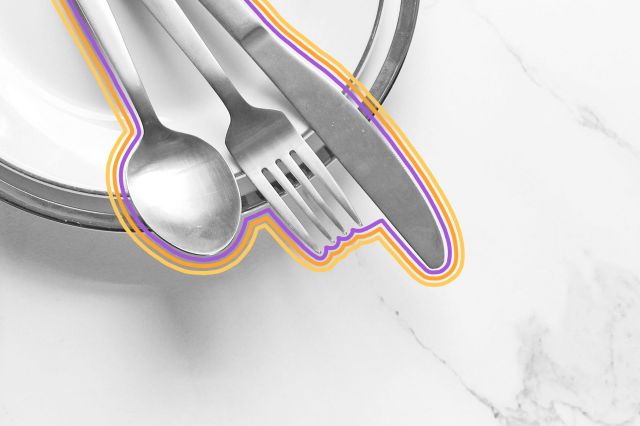
When It Comes to Silverware, Work From the Outside In
A formal dinner setting might have three or more forks, and just as many knives and spoons. It can all get a bit confusing. You may be confronted with a shellfish fork, a soup spoon, or a fish knife and fork, all in addition to the main dinner knife and fork. For some multiple-course meals, utensils may be brought in with each course. This is especially true for salad and dessert courses, and it makes it easier to know what to use. When in doubt, the basic rule to remember is that you should always start at the outside and work your way inward so that the largest tools are used for the main course. Another helpful tip is to wait for the host or hostess to begin eating. Not only is it good manners to do so, but it also allows you to see which implement they are using.

Put Your Napkin on Your Lap
The first paper napkins are believed to have appeared in ancient China, where they were used in little baskets that carried tea cups. Before that, many cultures (including the Romans) used finger bowls for wiping food remnants from their hands. During the Middle Ages, most people used whatever was available, usually a sleeve, for wiping their mouths. That slowly changed, with nobles using a separate cloth or nappe. This may have started as a giant tablecloth, but eventually became what we recognize today as a cloth napkin. Of course, napkins eventually developed their own rules of etiquette. When sitting down to eat, it is polite to take the napkin and spread it on your lap. Do not tuck it into the neck of your shirt. Use it to gently dab at your mouth during the meal and, when finished, leave the napkin loosely folded on the table.

Wait on the Bread
It’s an all-too-common scenario. By the time the entrée arrives at a restaurant, everyone has eaten their fill of bread. But at a formal dinner, the bread is to be eaten with the courses, rather than by itself. So as tempting as the smell of freshly baked bread may be, wait.
There are also rules about how to eat the bread. Do not spread the entire slice with butter. Likewise, don’t cut a bread roll in half and butter both halves. The reasoning is that this may leave you with butter smeared across your face. The correct way to eat it is to break off a small piece and butter just that piece. Continue to butter one bite at a time. And to avoid confusion, the bread plate is to your left.
More Interesting Reads

Consider Adopting the Continental Style
The American method of using eating utensils is often very different from the Continental, or European, method, which can lead to some confused looks on either side of the Atlantic. Each style is correct, but one may be more appropriate depending on the setting. The Continental style is to hold the fork in your left hand with the tines facing down. The knife is held in the right hand. The index finger of each hand is extended along the utensil. Meanwhile, the American method often sees the fork being transferred from one hand while cutting food to the other while eating. Etiquette experts advise that the Continental style may be “the most diplomatic.” Again, if in doubt, it is always wise to default to copying your host.

No Elbows on the Table (But Only While Eating)
Where and why did the rule about no elbows on the table originate? No one seems to know for sure, but the rule is common to many cultures. There is even a reference to it in the Old Testament of the Bible. In the 16th century, the Dutch philosopher Erasmus warned that only those weakened by old age or infirmity should rest their elbows on the table. More recently, Emily Post continues to caution against it, unless engaging in conversation between courses. Some believe that the use of elbows could once have been seen as a sign of intimidation or potential violence. Martha Stewart claims that resting one’s elbows increases the likelihood of slouching, which was once considered, in itself, rude. Whatever the reasoning, most people agree that elbows on the table while eating can be seen as impolite and can intrude upon your neighbor’s space.

Pay Attention to Local Customs
Table etiquette varies from one country to another. To avoid insulting a host when dining overseas, it can be useful to brush up on local manners. If eating with your hands in India and parts of the Middle East, remember to always use the right hand, as the left is considered unclean. Slurping one’s noodles may be a definite faux pas in the U.S., but in Japan and China, it is a sign of appreciation. In France, any bread on the table is to be eaten during the meal, not before. Furthermore, to avoid offending your French dinner host, both hands should rest on the table and not in your lap when you’re not eating. Meanwhile, never use your fork as a scoop for your peas in the United Kingdom. Although it may seem very impractical, the “proper” way is to use the tines of your fork to lightly squash a small amount at a time, or stick them to some mashed potatoes.











